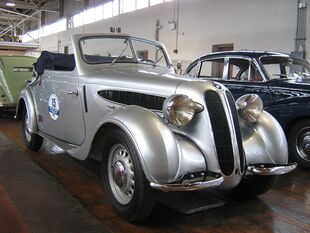Engineering:BMW 320
| BMW 320 | |
|---|---|
 BMW 320 cabriolet | |
| Overview | |
| Manufacturer | BMW |
| Production | 1937–1938 |
| Assembly | Germany: Eisenach |
| Body and chassis | |
| Class | Mid-size car |
| Body style | 2-door saloon 2-door cabriolet |
| Layout | FR layout |
| Related | BMW 315, BMW 329 (suspension) BMW 326 (engine, chassis)[1] |
| Powertrain | |
| Engine | 1971 cc OHV M78 straight-6 |
| Transmission | 4-speed manual[2][3] |
| Dimensions | |
| Wheelbase | 2,750 mm (108.3 in)[2][1] |
| Length | 4,500 mm (177.2 in)[2] |
| Width | 1,540 mm (60.6 in)[2] |
| Height | 1,500 mm (59.1 in)[2] |
| uk|uk|Kerb|Curb}} weight | 1,000 kg (2,204.6 lb)[2] |
| Chronology | |
| Predecessor | BMW 329 |
| Successor | BMW 321 |
The BMW 320 was a car manufactured by Bayerische Motoren Werke AG also known as BMW in Germany from 1937 to 1938, the successor to the 319-based BMW 329. It was offered in 2 door saloon and convertible versions. Approximately 4,200 cars were made, of which 1,835 were cabriolets. [4]
The car was first presented in July 1937. It showed a very similar resemblance to the 329. It was a high performance car with many admirers. The 320 was built on a shortened BMW 326 frame and used a 326 engine with a single carburettor and an output of 45 hp (34 kW). The 320 had a top speed of 65mph. The suspension, which was carried over from the 329, consisted of an independent front suspension with a high-mounted transverse leaf spring acting as upper control arms and a conventional live axle on semi-elliptic springs at the rear. It had a slightly greater displacement 6-cylinder engine. It was available as a two-door sedan or two-door convertible and stayed until 1938. The BMW 320 was smaller, less expensive, and lighter than its predecessor. It offered easy handling, a fine finish, and a good power-to-weight ratio.[1]
The 320 was replaced by the BMW 321 in 1938.
References
- Citations
- ↑ 1.0 1.1 1.2 Norbye, p.47
- ↑ 2.0 2.1 2.2 2.3 2.4 2.5 "Carfolio.com: 1937 BMW 320 Saloon". Carfolio.com. Carfolio.com. 2008-04-03. http://www.carfolio.com/specifications/models/car/?car=101750.
- ↑ "Conceptcarz.com 1937 BMW 320 Specifications". Conceptcarz.com. Daniel Vaughan. http://www.conceptcarz.com/vehicle/default.aspx?carID=5932&catID=0&eventID=&i=2#menu.
- ↑ BMW 320, www.bmwdrives.com Retrieved 9 December 2016
- Bibliography
- Norbye, Jan P. (1984). BMW - Bavaria's Driving Machines. Skokie, IL: Publications International. ISBN 0-517-42464-9. https://archive.org/details/bmwbavariasdrivi00norb.
 |

